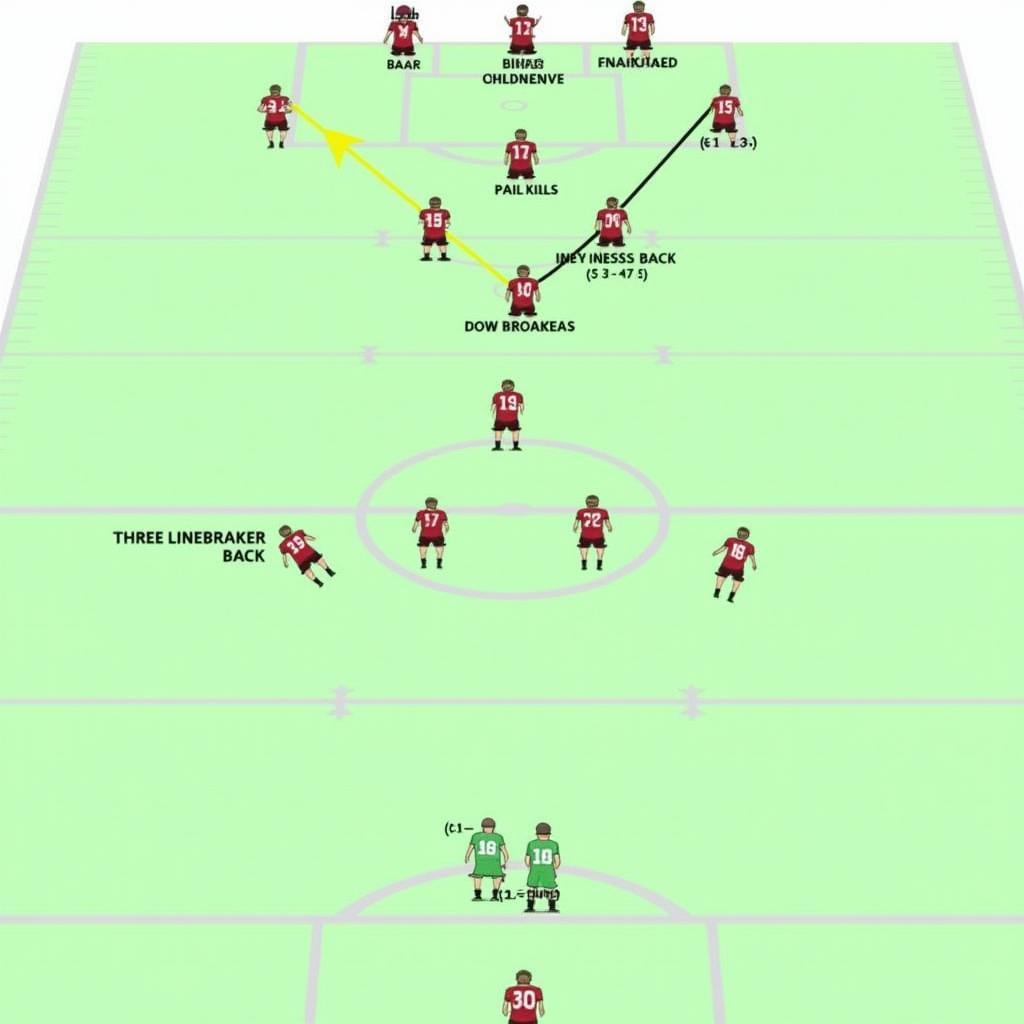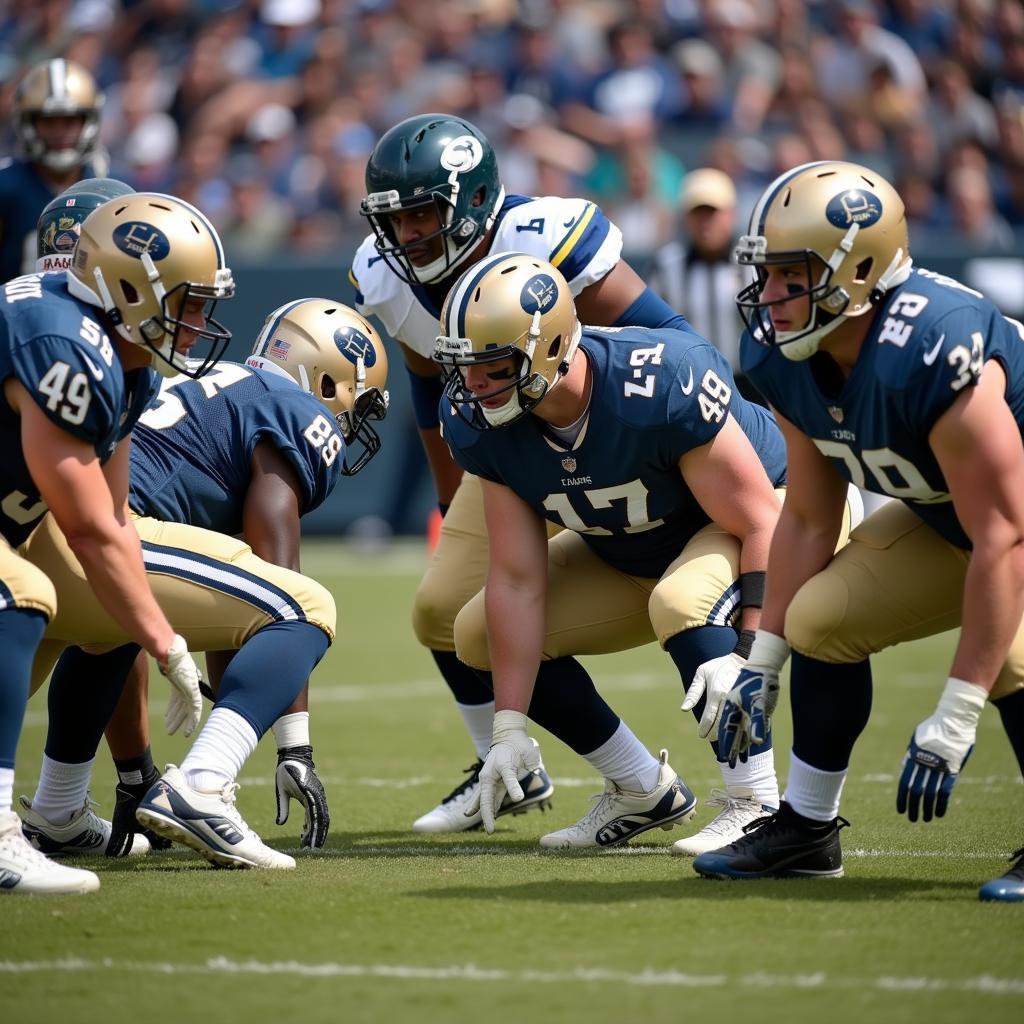The 3-3 defense is a versatile and adaptable defensive scheme in football that can be highly effective when executed correctly. This comprehensive guide will delve into the intricacies of this defense, exploring its strengths, weaknesses, and key principles.
 3-3 Defense Formation
3-3 Defense Formation
Understanding the Basics: Personnel and Alignment
The 3-3 defense, as its name suggests, employs three down linemen and three linebackers. This alignment allows for flexibility in defensive fronts and coverage schemes. The three linemen are typically responsible for controlling the line of scrimmage, while the three linebackers roam the field, covering zones or assigned players. The remaining five defensive backs provide support against the pass and run.
Strengths of the 3-3 Defense
The 3-3 defense offers several advantages, making it an attractive option for many teams:
- Versatility: One of the primary strengths lies in its adaptability to various offensive formations and plays. Coaches can easily adjust alignments, blitzes, and coverages to counter specific offensive threats.
- Disguising Coverage: The 3-3 defense excels at disguising coverage schemes, making it difficult for quarterbacks to decipher pre-snap reads. The interchangeable roles of linebackers and defensive backs add to this element of surprise.
- Strong Against the Run: With three down linemen and three linebackers, the 3-3 defense can effectively clog running lanes and limit offensive gains on the ground. This strength makes it particularly effective against run-heavy offenses.
Weaknesses of the 3-3 Defense
Despite its strengths, the 3-3 defense also presents certain vulnerabilities:
- Susceptibility to Play-Action Passing: The aggressive nature of the 3-3 defense, particularly its tendency to commit players to stopping the run, can leave it vulnerable to play-action passes.
- Challenges Against Spread Offenses: Modern spread offenses, characterized by wide receiver alignments and quick passing attacks, can exploit the spacing in a 3-3 defense.
Key Principles of the 3-3 Defense
Effective execution of the 3-3 defense hinges on several key principles:
- Aggressive Linebackers: Linebackers play a pivotal role, tasked with both stuffing the run and dropping into coverage. Their speed, instincts, and ability to read plays quickly are crucial.
- Disciplined Defensive Backs: With the potential for mismatches against receivers, defensive backs must exhibit exceptional coverage skills, discipline, and communication to prevent big plays.
- Coordinated Stunts and Blitzes: The 3-3 defense thrives on well-timed and coordinated stunts and blitzes. These maneuvers can disrupt offensive timing and create pressure on the quarterback.
Variations and Adaptations
Coaches have developed numerous variations of the 3-3 defense to address specific offensive schemes or leverage player strengths. Some common adaptations include:
- 3-4 Defense Cover 3: This variation combines the 3-4 defense’s personnel with Cover 3 principles, providing a balanced approach against both the run and pass. Learn more about the 3-4 defense cover 3 in our dedicated guide.
- Fire Zone Blitzes: These aggressive blitzes send multiple defenders after the quarterback while dropping others into zone coverage, aiming to force quick throws or create turnovers.
Mastering the 3-3 Defense: Tips and Strategies
- Film Study: Thorough film study of upcoming opponents helps identify offensive tendencies, formations, and key players, allowing for tailored defensive adjustments.
- Communication is Key: Effective communication among all defensive players, especially pre-snap, is paramount to ensure everyone understands their assignments and adjustments.
- Practice and Repetition: Like any defensive scheme, consistent practice and repetition are essential for players to master their roles, responsibilities, and the intricacies of the 3-3 defense.
 Linebacker Reading the Offense
Linebacker Reading the Offense
Frequently Asked Questions about the 3-3 Defense
1. What are the key positions in a 3-3 defense?
The essential positions include three down linemen, three linebackers (often a MIKE, SAM, and WILL), and five defensive backs comprising cornerbacks, safeties, and potentially a nickelback.
2. Is the 3-3 defense effective in modern football?
While its popularity has fluctuated, the 3-3 defense remains relevant. Its adaptability and effectiveness against the run make it a valuable tool for teams facing specific offensive styles.
3. What are some successful examples of the 3-3 defense in football history?
Legendary coach Buddy Ryan’s “46 defense” with the Chicago Bears incorporated elements of the 3-3, showcasing its potential for dominance.
4. How can I learn more about specific 3-3 defense playbooks and strategies?
For those seeking in-depth knowledge, resources like a 4-3 defense playbook pdf or a 3-5-3 defense playbook pdf provide comprehensive insights.
5. What are the biggest challenges for players in a 3-3 defense?
Players, particularly linebackers, face the challenge of quickly diagnosing run or pass plays and fulfilling their assignments effectively.
Conclusion
The 3-3 defense presents a unique set of challenges and rewards for teams. Its versatility, ability to disguise coverage, and strength against the run make it a potent defensive scheme. However, its susceptibility to play-action passes and challenges against spread offenses require careful planning and execution. By understanding its core principles, variations, and key coaching points, teams can effectively utilize the 3-3 defense to disrupt opponents and achieve success on the field.
Need further assistance with defensive strategies? Contact our team at 0902476650, email us at [email protected], or visit us at 139 Đ. Võ Văn Kiệt, Hoà Long, Bà Rịa, Bà Rịa – Vũng Tàu, Việt Nam. Our 24/7 support team is always ready to help!





